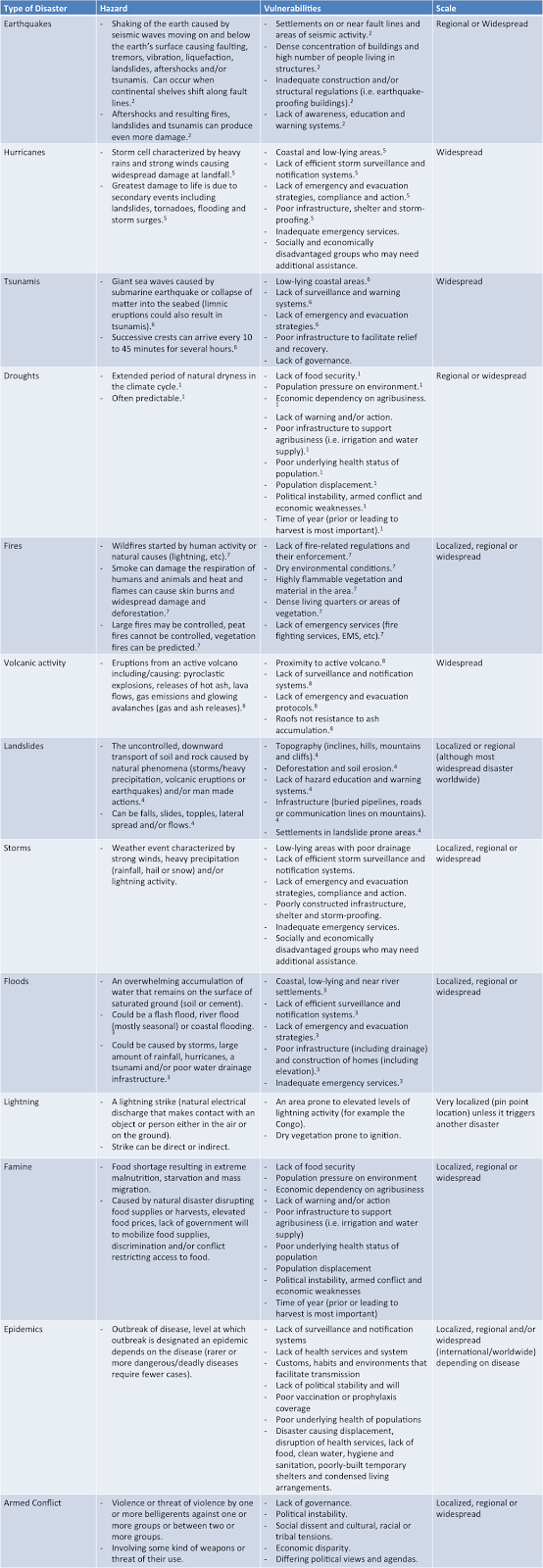The process of disaster management requires the identification and consideration of the various characteristics of different disasters.
The following table classifies disasters based on their onset and duration.
I have rearranged the next three tables to reflect how I wanted to display the other characteristics of disasters.
The next table details the hazard, vulnerabilities and scale typical of each type of disaster.
Ultimately, I found that the most interesting information provided by the World Health Organisation technical hazard sheets were the details regarding the recommended and inappropriate responses. These are found in the next table.
Another important commonality that I noticed was that the best approach to disaster management always involves building local capacity and relying on the local teams and resources, regardless of the disaster. Prevention in any manner possible is also always better than having to react and respond after the fact. That is not to say that I was not initially surprised by the consistent opposition to sending help including medical and paramedical staff since that seems like such a standard thing to do in an emergency situation.
Building local capacity and resilience will be the topic of the blog post "Disaster Management: Building Resilient Cities" in recognition of the importance of that process.
References for tables:
1. WHO 2015, DROUGHT – Technical Hazard Sheet – Natural Disaster Profiles, viewed 2nd January 2015, <http://www.who.int/hac/techguidance/ems/drought/en/>.
2. WHO 2015, EARTHQUAKES– Technical Hazard Sheet – Natural Disaster Profiles, viewed 2nd January 2015, <http://www.who.int/hac/techguidance/ems/earthquakes/en/>.
3. WHO 2015, FLOODS– Technical Hazard Sheet – Natural Disaster Profiles, viewed 2nd January 2015, <http://www.who.int/hac/techguidance/ems/floods/en/>.
4. WHO 2015, LANDSLIDES – Technical Hazard Sheet – Natural Disaster Profiles, viewed 2nd January 2015, <http://www.who.int/hac/techguidance/ems/landslides/en/>
5. WHO 2015, TROPICAL CYCLONES – Technical Hazard Sheet – Natural Disaster Profiles, viewed 2nd January 2015, <http://www.who.int/hac/techguidance/ems/tropical_cyclones/en/>.
6. WHO 2015, TSUNAMIS – Technical Hazard Sheet – Natural Disaster Profiles, viewed 2nd January 2015, <http://www.who.int/hac/techguidance/ems/tsunamis/en/>.
7. WHO 2015, VEGETATION FIRES – Technical Hazard Sheet – Natural Disaster Profiles, viewed 2nd January 2015, <http://www.who.int/hac/techguidance/ems/vegetation_fires/en/>.
8. WHO 2015, VOLCANOS – Technical Hazard Sheet – Natural Disaster Profiles, viewed 2nd January 2015, <http://www.who.int/hac/techguidance/ems/volcanos/en/>.
P.S. While it was difficult for me to decipher whether the answers in some of my tables were entirely correct as there was a degree of interpretation involved, I did manage to find a table in the Sphere Handbook that includes some health impact information that I believe will be quite useful to me in the future.
Sphere Handbook: Public health impact of selected disasters
 |
| (Modified from: The Sphere Project 2011, pp. 293) |
Reference:
The Sphere Project 2011, Humanitarian Charter and Minimum Standards in Humanitarian Response, 3rd edn, The Sphere Project, Geneva.
Eryn




No comments:
Post a Comment